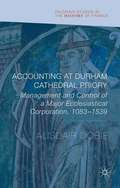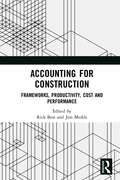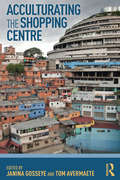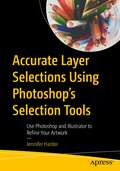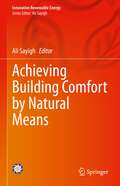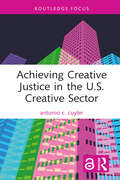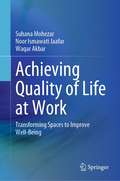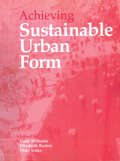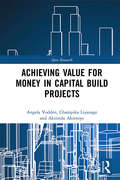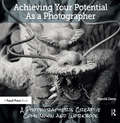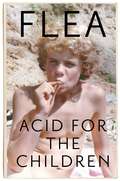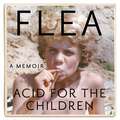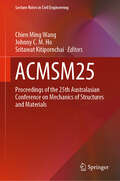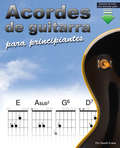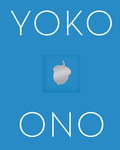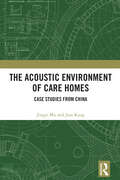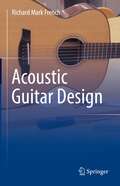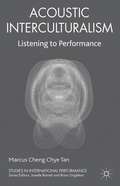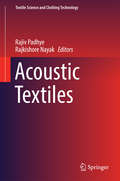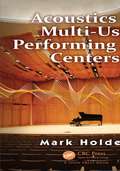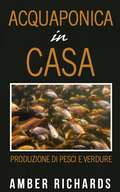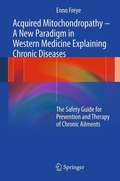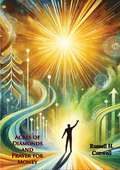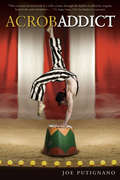- Table View
- List View
Accounting at Durham Cathedral Priory: Management And Control Of A Major Ecclesiastical Corporation 1083-1540 (Palgrave Studies in the History of Finance)
by Alisdair DobieThis study utilizes the rich archives which survive at Durham Cathedral to examine the way in which accounting methods and systems were adopted and adapted to manage income and expenses, assets and liabilities in changing economic environments.
Accounting for Construction: Frameworks, Productivity, Cost and Performance
by Rick Best Jim MeikleAccounting for Construction follows on from Measuring Construction, edited by the same team. It extends the coverage of some of the material in the first volume and expands the range of related topics to include, inter alia, shadow economies, accounting for informal construction and the treatment of the built environment sector in national accounts. Taken together, the two volumes collate a range of topics that are only addressed, if addressed at all, in occasional academic papers and the publications of bodies such as national statistical offices and the World Bank. Accounting for Construction presents international examples from the UK, Australia and New Zealand and from both academic and professional contributors. This book is essential reading for all researchers and professionals interested in construction economics, construction management, and anyone interested in how the construction industry affects the global economy in ways previously under-represented in the literature.
Acculturating the Shopping Centre
by Janina Gosseye Tom AvermaeteAcculturating the Shopping Centre examines whether the shopping centre should be qualified as a global architectural type that effortlessly moves across national and cultural borders in the slipstream of neo-liberal globalization, or should instead be understood as a geographically and temporally bound expression of negotiations between mall developers (representatives of a global logic of capitalist accumulation) on the one hand, and local actors (architects/governments/citizens) on the other. It explores how the shopping centre adapts to new cultural contexts, and questions whether this commercial type has the capacity to disrupt or even amend the conditions that it encounters. Including more than 50 illustrations, this book considers the evolving architecture of shopping centres. It would be beneficial to academics and students across a number of areas such as architecture, urban design, cultural geography and sociology.
Accumulation: The Art, Architecture, and Media of Climate Change (e-flux Architecture)
by Nick Axel, Daniel A. Barber, Nikolaus Hirsch, Anton VidokleExamines how images of accumulation help open up the climate to political mobilization The current epoch is one of accumulation: not only of capital but also of raw, often unruly material, from plastic in the ocean and carbon in the atmosphere to people, buildings, and cities. Alongside this material growth, image-making practices embedded within the fields of art and architecture have proven to be fertile, mobile, and capacious. Images of accumulation help open up the climate to cultural inquiry and political mobilization and have formed a cultural infrastructure focused on the relationships between humans, other species, and their environments.The essays in Accumulation address this cultural infrastructure and the methodological challenges of its analysis. They offer a response to the relative invisibility of the climate now seen as material manifestations of social behavior. Contributors outline opportunities and ambitions of visual scholarship as a means to encounter the challenges emergent in the current moment: how can climate become visible, culturally and politically? Knowledge of climatic instability can change collective behavior and offer other trajectories, counteraccumulations that draw the present into a different, more livable, future.Contributors: Emily Apter, New York U; Hans Baumann; Amanda Boeztkes, U of Guelph; Dominic Boyer, Rice U; Lindsay Bremner, U of Westminster; Nerea Calvillo, U of Warwick; Beth Cullen, U of Westminster; T. J. Demos, U of California, Santa Cruz; Jeff Diamanti, U of Amsterdam; Jennifer Ferng, U of Sydney; Jennifer Gabrys, U of Cambridge; Ian Gray, U of California, Los Angeles; Gökçe Günel, Rice U; Orit Halpern, Concordia U; Gabrielle Hecht, Stanford U; Cymene Howe, Rice U; Wendy Hui Kyong Chun, Simon Fraser U; Robin Kelsey, Harvard U; Bruno Latour, Sciences Po, Paris; Hannah le Roux, U of the Witwatersrand, Johannesburg; Stephanie LeMenager, U of Oregon; Nashin Mahtani; Kiel Moe, McGill U; Karen Pinkus, Cornell U; Stephanie Wakefield, Life U; McKenzie Wark, The New School; Kathryn Yusoff, Queen Mary U of London.
Accurate Layer Selections Using Photoshop’s Selection Tools: Use Photoshop and Illustrator to Refine Your Artwork
by Jennifer HarderTake your hand-drawn illustrations to the next level by using various selection tools in Photoshop to clean up the artwork, and Illustrator for final refinement. Also, learn to save your artwork as vector images to be used for web, print, or even stills for character animation. Author Jennifer Harder begins by showing you how to use basic tools in Photoshop to clean up your artwork, followed by Marquee tools and more. Next, you will see how to use more advanced tools such as Lasso, Magic Wand, the Object Selection tool, and so on. You’ll then get a demonstration of how to control the type of selection using the selection main menu, how to copy selections to another layer, and how to use the focus area. This is followed by a chapter that covers paths, channels, and layer masks that you will master to clean up your artwork. To round things out, you will learn how to use Illustrator’s different features to further enhance your work. On completing the book, you will have mastered how to make your artwork and illustrations portfolio-ready. What You Will LearnMaster each selection tool found in PhotoshopChoose the right tools for cleaning and refining artworkSave selections for other projectsMake your artwork scalable in Illustrator using various methods Who Is This Book For Readers with little-to-intermediate-level experience with Photoshop.
Achieving Building Comfort by Natural Means (Innovative Renewable Energy)
by Ali SayighAchieving Building Comfort by Natural Means explores examples of green building designs and methods that are currently being used around the world to achieve human comfort in buildings. The operation of buildings accounts for more than 40% of total energy use and is a major source of carbon emissions. It is imperative that this consumption be substantially decreased and that energy needed for building comfort is obtained from renewable and environmentally friendly sources. This book brings together a global group of contributors who look at factors such as location, climate, building materials, energy management, ventilation, thermal environmental conditions, shading, lighting, acoustics, and more that are critical for achieving buildings that are more sustainable.Thermal comfort and climatic potential of ventilative cooling in Italian climates is available open access under a Creative Commons Attribution 4.0 International License via link.springer.com.
Achieving Creative Justice in the U.S. Creative Sector (Routledge Focus on the Global Creative Economy)
by antonio c. cuylerCaste and the discrimination, exclusion, marginalization, othering, oppression, subalterning, and subjugation that it produces continue to challenge creative industries compromising culture’s verisimilitude as a public good. Achieving Creative Justice in the U.S. Creative Sector explores the relationships between access, diversity, equity, and inclusion (ADEI), and creative justice in the U.S. creative sector as a solution to meaningfully address enduring creative injustices.Whether it’s the #BlackLivesMatter, #LandBack, or #MeToo movements, caste remains structurally and systemically built into U.S. Society, and thereby the creative sector. Acknowledging this realization after George Floyd’s murder in 2020 has galvanized a quest for solutions. This book encourages sincere consideration for the human toll of insisting on artistic excellence and artistic merit at the expense of profound and unnecessary identity-based human suffering.Providing a practical guide on how to activate ADEI to achieve creative justice and a research agenda, this book is an essential reading for practitioners and scholars who feel compelled to address creative injustices that constrain the creative flourishing of historically and continuously low-casted peoples throughout the entire cultural ecosystem that defines the U.S. creative sector.The Open Access version of this book, available at http://www.taylorfrancis.com, has been made available under a Creative Commons [Attribution-Non Commercial-No Derivatives (CC BY-NC-ND)] 4.0 license.
Achieving Quality of Life at Work: Transforming Spaces to Improve Well-Being
by Suhana Mohezar Noor Ismawati Jaafar Waqar AkbarThis book provides an understanding and imaging of how a stress-free workplace might be designed and implemented in the context of the ‘new normal.’ Statistics show that more and more people are experiencing an increase in work-related stress, and its impact on individual psychology and well-being as well as organizational performance can be devastating. Globally, the most recent data on work-related illnesses account for 2.4 million deaths. Against this backdrop, and taking stock of how the pandemic is affecting the workplace and employee well-being, this book proposes transformations in work spaces, from implementing effective “greening” features, to more efficient technology-supported spaces. It establishes links between workplace design and creativity, happiness and productivity, confronting related issues such as generation gaps, digital interruptions, collaborative work environments and sustainability, and their respective connections with workspace environment and well-being. The book situates this discussion within a broader discussion on work and quality of life. Furthermore, the book demonstrates how several sustainable development goals might be achieved through transformed work spaces. Through an intersection between organizational psychology, well-being and quality of life studies, sociology, human resources, and ergonomics, this book is a timely examination of work-related stress in relation to work spaces that require rethinking and transformation in the throes, and wake, of the pandemic.
Achieving Sustainable Urban Form
by Katie Williams Elizabeth Burton Mike JenksAchieving Sustainable Urban Form represents a major advance in the sustainable development debate. It presents research which defines elements of sustainable urban form - density, size, configuration, detailed design and quality - from macro to micro scale. Case studies from Europe, the USA and Australia are used to illustrate good practice within the fields of planning, urban design and architecture.
Achieving Value for Money in Capital Build Projects (Spon Research)
by Angela Vodden Champika Liyanage Akintola AkintoyeThis book is the first to bring together academic and practitioner views of Value for Money (VFM). VFM has been used to assess whether or not an organisation has obtained the maximum benefit within the resources available to it. A concept used by the public sector to assess the benefits of major built environment projects, it has become a major tenet of public private partnerships, capital project infrastructure and civil engineering megaprojects. This book presents and discusses the various debates surrounding the concept of Value for Money. It provides an international perspective on VFM by drawing upon the existing and fast developing body of principles and practices for Capital Build Projects. Readers will gain a level of understanding of the issues involved, the challenges, opportunities and the support mechanisms and protocols required for implementation of VFM in capital building development. Ultimately, the book presents a protocol that has been developed to track and monitor the VFM of a capital project from day 1, an Equilibrium Testing Mechanism (ETM) developed by the authors. This testing mechanism allows each of the parties to a project to monitor their VFM position at any given stage of a project from the beginning to the end of the build stage and beyond as necessary. This book is both a useful reference for researchers and a practical guide for the construction and engineering industry.
Achieving Your Potential As A Photographer: A Creative Companion and Workbook
by Harold DavisComing from the perspective that true inspiration and great image making are at the core of any high-level photographic endeavour, Achieving Your Potential as a Digital Photographer presents an organized and cohesive plan for kickstarting creativity, and then taking the resulting work into the real world. The ideas presented have been formulated by Harold Davis over many years working as a creative artist and award-wining photographer, and in the celebrated workshops he has developed and led all around the world. These concepts are presented with accompanying exercises so that readers can put them into everyday practice as well as workbook pages bound into the book for note taking and journaling. This book will enrich your photographic practice whether the goal is simply to enrich your photography or to make money from your work.
Acid For The Children - The autobiography of Flea, the Red Hot Chili Peppers legend: A Memoir
by FleaFlea, the iconic bassist and co-founder, alongside Anthony Kiedis, of the immortal Red Hot Chili Peppers finally tells his fascinating origin story, complete with all the dizzying highs and the gutter lows you'd expect from an LA street rat turned world-famous rock star.Michael Peter Balzary was born in Melbourne, Australia, on October 16, 1962. His more famous stage name, Flea, and his wild ride as the renowned bass player for the Red Hot Chili Peppers was in a far and distant future. Little Michael from Oz moved with his very conservative, very normal family to Westchester, New York, where life as he knew it was soon turned upside down. His parents split up and he and his sister moved into the home of his mother's free-wheeling, jazz musician boyfriend - trading in rules, stability, and barbecues for bohemian values, wildness, and Sunday afternoon jazz parties where booze, weed, and music flowed in equal measure. There began Michael's life-long journey to channel all the frustration, loneliness, love, and joy he felt into incredible rhythm.When Michael's family moved to Los Angeles in 1972, his home situation was rockier than ever. He sought out a sense of belonging elsewhere, spending most of his days partying, playing basketball, and committing petty crimes. At Fairfax High School, he met another social outcast, Anthony Kiedis, who quickly became his soul brother, the yin to his yang, his partner in mischief. Michael joined some bands, fell in love with performing, and honed his skills. But it wasn't until the night when Anthony, excited after catching a Grandmaster Flash concert, suggested they start their own band that he is handed the magic key to the cosmic kingdom.Acid for the Children is as raw, entertaining and wildly unpredictable as its author. It's both a tenderly evocative coming of age story and a raucous love letter to the power of music and creativity
Acid For The Children - The autobiography of Flea, the Red Hot Chili Peppers legend
by FleaThe strange tale of a boy named Flea starts in Rye, NY. It was all very normal. But soon his parents divorced and his mother Patricia remarried a jazz musician. Flea's stepfather frequently invited musicians to his house for jam sessions which sparked Flea's interest in music. The family moved to Los Angeles, where Flea became fascinated with the trumpet, idolizing musicians like Miles, Dizzy, and Louis.But the family soon fell apart, "I was raised in a very violent, alcoholic household," Flea later said. "I grew up being terrified of my parents, particularly my father figures. It caused [me] a lot of trouble later in life." He began smoking weed at 13, and became a daily user of harder drugs. He was on the streets by 14 and soon after, met another social outcast and drug user named Anthony Kiedis. They form a band that would become the Red Hot Chili Peppers.ACID FOR THE CHILDREN is pure, uncut Flea, with nothing left unsaid.(P)2018 Hachette Audio
ACMSM25: Proceedings of the 25th Australasian Conference on Mechanics of Structures and Materials (Lecture Notes in Civil Engineering #37)
by Chien Ming Wang Johnny C. M. Ho Sritawat KitipornchaiThis book presents articles from The Australasian Conference on the Mechanics of Structures and Materials (ACMSM25 held in Brisbane, December 2018), celebrating the 50th anniversary of the conference. First held in Sydney in 1967, it is one of the longest running conferences of its kind, taking place every 2–3 years in Australia or New Zealand. Bringing together international experts and leaders to disseminate recent research findings in the fields of structural mechanics, civil engineering and materials, it offers a forum for participants from around the world to review, discuss and present the latest developments in the broad discipline of mechanics and materials in civil engineering.
Acordes de guitarra para principiantes: Un libro de acordes de guitarra para principiantes con acordes abiertos y más
by Gareth Evans"Es un libro muy completo que contiene acordes de las etapas iniciales y posteriores. Todo está muy bien explicado. Se lo recomiendo a cualquiera que esté empezando con la guitarra". Nigel Elliott, Guitarrista y Tutor (Irlanda del Norte) Acordes de guitarra para principiantes contiene 65 acordes diferentes arreglados en digitaciones fáciles. - Technique La técnica de la mano del diapasón para tocar los acordes de la guitarra se analiza en detalle con diagramas. Cuando es necesario, algunos acordes se enseñan de forma gradual porque hacer sólo los aspectos más difíciles de la digitación de un acorde primero, permite que la mano sea más libre de ajustarse. Otros acordes se muestran con diferentes digitaciones para que puedas elegir el que prefieras. Tocar los acordes de guitarra puede parecer una contorsión para las manos del principiante, por eso hay una guía básica sobre cómo estirarlas para mantener las manos flexibles. - Audio y más Cada acorde de guitarra tiene un ejemplo de audio descargable que te permite escuchar si lo has tocado bien, o escuchar lo que necesitas mejorar. Hay una introducción a los acordes de potencia y a los acordes de cejilla, en los que los acordes de cejilla se muestran como versiones más sencillas de las formas de los acordes de cejilla completa. En la parte posterior de Acordes de guitarra para principiantes hay una lista de canciones sugeridas que contienen acordes del libro. ¡Consigue tu copia hoy! "Se ve muy bien. Me gustan especialmente las diferentes formas de tocar el acorde de A. Los ejercicios de calentamiento para la flexibilidad también son buenos. Es bueno que los acordes de cejilla se muestren como versiones parciales para hacerlos inicialmente más fáciles, y los principiantes pueden encontrar más aspectos interesantes cerca de la parte posterior del libro, donde se muestran versiones abiertas fáciles de otros acordes más exóticos, como Dm(maj7), el acorde de "James Bond"". Campbell Murray, RGT & MU Tutor Registrado (Escocia)
Acorn
by Yoko Ono"It's nearly 50 years ago that my book of conceptual instructions Grapefruit was first published. In these pages I'm picking up where I left off. After each day of sharing the instructions you should feel free to question, discuss, and/or report what your mind tells you. I'm just planting the seeds. Have fun." - Yoko OnoLegendary avant-garde icon Yoko Ono has inspired generations of artists and performers. In Acorn, she offers enchanting and thought-provoking exercises that open our eyes-and all of our senses - to more creative and mindful ways of relating to ourselves, each other, and the planet we cohabit. Throughout this beautifully designed book are 100 black-and-white line drawings by Yoko. Like this legendary woman herself, the book is wildly original, stimulating, and hard to label: call it purposeful play, call it brain poetry, call it guided motivation, call it Zen-like incantations, call it whatever you want. But read it. Acorn may change the way you experience the world.
The Acoustic Environment of Care Homes: Case Studies from China
by Jingyi Mu Jian KangThis book examines the indoor acoustic environment of China's care homes. Chapter 1 provides a brief introduction to the current situation in China's care homes. This includes the distribution, size, demand, and future development direction of these facilities. The chapter then presents an in-depth introduction and analysis of the indoor environment of these facilities, especially the acoustic environment. In Chapter 2, a case study and site investigation are described, and these are used to analyse the current state of the acoustic environment in these facilities, including the sound pressure level (SPL) and reverberation time (RT). Chapter 3 details the perceptions of the elderly regarding the acoustic environment of care homes and the correlation between the sound environment and other physical environments at the facilities. Chapter 4 presents the impact of the acoustic environment on the well-being of elderly residents and an analysis of the effects of different sound sources on the activities of the elderly. The effects of the acoustic environment on physiological indices of the elderly under different sound sources in care homes are analysed in Chapter 5. Finally, in Chapter 6, certain improvement strategies for the indoor acoustic environment of care homes are proposed based on the analysis. This book is a comprehensive exposition of research on the acoustic environment of care homes in China, and is useful reading for researchers in acoustics, architecture, design, engineering, and healthcare facilities. It could also be used as a scientific introduction for readers interested in this field.
Acoustic Guitar Design
by Richard Mark FrenchThis book is for experienced luthiers and guitar designers in the industry, novice builders wishing to improve their designs, and guitar owners interested in knowing more about their instruments. It includes the most important technical information gathered from many sources, including the academic literature and the author’s own work, presented here in a clear, actionable form with a minimum of mathematics. The book begins with a historical survey on how important features of the acoustic guitar evolved over centuries. The review leads up to a chapter focusing on three iconic instruments that represent the most important types of acoustic guitars: classical, steel string flat top and archtop. As the guitar market is so strongly conditioned by familiar, traditional instruments, a successful builder must have a thorough working understanding of the most important designs to underpin their own work. Through this volume, Professor French lays out the entire design process and collects detailed information in one convenient source. Luthiers quite often compile notebooks of measurements, part numbers, specific design features and other details they routinely need. This book organizes much of that information, with tables of dimensions, material properties, and other details in one essential final chapter. The book also features concise side bar contributions by top guitar designers and builders including Tim Shaw, Chief Engineer at Fender Music; Bob Taylor, Co-Founder of Taylor Guitars; and Andy Powers, Master Guitar Designer and Partner.
Acoustic Interculturalism
by Marcus Cheng Chye TanAcoustic Interculturalism is a study of the soundscapes of intercultural performance through the examination of sound's performativity. Employing an interdisciplinary approach, the book examines an akoumenological reception of sound to postulate the need for an acoustic knowing - an awareness of how sound shapes the intercultural experience.
Acoustic Textiles (Textile Science and Clothing Technology)
by Rajiv Padhye Rajkishore NayakThis book highlights the manufacturing and applications of acoustic textiles in various industries. It also includes examples from different industries in which acoustic textiles can be used to absorb noise and help reduce the impact of noise at the workplace. Given the importance of noise reduction in the working environment in several industries, the book offers a valuable guide for companies, educators and researchers involved with acoustic materials.
Acoustics of Multi-Use Performing Arts Centers
by Mark HoldenMulti-use performing arts centers are among the most complex of all building types and require excellent and flexible acoustics in order to suit the facility's varied programming needs. This technical and practical book by renowned acoustician Mark Holden delivers a full discussion of the challenges and solutions that arise in the concept, design, construction and commissioning phases. It serves students, architects, engineers, designers and acousticians.
Acquaponica In Casa
by Amber Richards Maria Antonietta RicagnoVi siete mai chiesti cosa sia l'acquaponica? È adatta a voi? Questo ebook vi offre una buona panoramica di questa tecnica e risponde a questa e molte altre domande. L'acquaponica è la scienza rivoluzionaria che prevede la coltura delle piante nell'acqua invece che nel terreno. Inoltre, nella stessa acqua è possibile allevare dei pesci o altre creature acquatiche, i cui rifiuti prodotti forniscono i nutrienti per le piante, che a loro volta depurano l'acqua. Quando viene realizzato correttamente, un impianto di acquaponica può essere autosostenibile e rappresentare al contempo una fonte sana di pesci e piante a uso alimentare. Acquaponica in casa è una guida per principianti che desiderano realizzare un impianto per hobby. Il libro vi fornisce le nozioni di base su questo meraviglioso e interessante modo di fare giardinaggio, incluso i componenti necessari e le modalità per realizzare il vostro impianto di acquaponica per produrre alimenti sani, freschi e deliziosi tutto l'anno. Scaricate subito la vostra copia.
Acquired Mitochondropathy – A New Paradigm in Western Medicine explaining Chronic Diseases
by Enno FreyeThe book on Acquired Mitochondropathy offers a new perspective on the understanding and the treatment of chronic ailments. Addressing a new paradigm deemed necessary, since in one of every four adults in the western world chronic ailments are on the rise. Resulting from energy dysfunction of cellular organelles, the mitochondria, the most of the common symptoms the physician faces during medical consultation are presented. An increasing focus on chronic disabilities presents difficulties for the busy practitioner, since patients typically describe a complex pattern of discomfort, disability, and distress, with pain affecting physical, social, and psychological functioning, which have to be put in the proper perspective. Since clinicians must efficiently condense widely varied symptomatic descriptions into characteristic patterns to permit accurate diagnosis and implement effective treatment, this book serves as a useful educational resource for the healthcare provider.
Acres of Diamonds and Prayer for Money
by Russell H. ConwellRussell H. Conwell’s "Acres of Diamonds and Prayer for Money" is a timeless work that combines two of his most influential writings, offering profound insights into achieving wealth and the power of faith in financial success. Conwell, a renowned Baptist minister, lawyer, and founder of Temple University, shares his inspirational message that opportunities for prosperity are often found in our own backyards.Acres of Diamonds:In his famous lecture, "Acres of Diamonds," Conwell tells the story of a Persian farmer who sells his land to search for diamonds, only to discover that the new owner finds a rich diamond mine on the very property he sold. Through this parable, Conwell illustrates that opportunities for wealth and success are often closer than we think and can be found through hard work, creativity, and perseverance. He emphasizes the importance of recognizing and capitalizing on the potential that lies within our immediate environment and resources.Key themes include:The value of hard work and determinationThe importance of recognizing and seizing local opportunitiesThe idea that wealth is not inherently evil but can be used for goodEncouragement to pursue one’s dreams and aspirations with vigor and resourcefulnessPrayer for Money:In "Prayer for Money," Conwell explores the relationship between faith and financial prosperity. He discusses the power of prayer and positive thinking in achieving financial goals, arguing that it is not wrong to ask for material blessings as long as the intention is to use them wisely and for the benefit of others. Conwell provides a thoughtful perspective on how spiritual practices can complement and enhance one’s efforts to attain financial stability and success."Acres of Diamonds and Prayer for Money" offers a holistic approach to prosperity, blending practical advice with spiritual wisdom. Conwell’s enduring message encourages readers to look within and around them for opportunities, to work diligently, and to maintain faith in their ability to achieve their financial and personal goals. This book is a valuable resource for anyone seeking to find success and fulfillment in both their professional and spiritual lives.
Acrobaddict
by Joe PutignanoFollow the author as he goes on a harrowing journey from the US Olympic Training Center to homeless shelters to shooting heroin on the job to being declared dead. This story goes beyond addiction. It is about the fragility and tenacity of the human spirit and how that spirit can redeem each and every one of us by helping to push us through the darkness, whether the darkness is from death, divorce, or the disease of addiction.Acrobaddict is a story about the close relationship between athletics and drug addiction-how the same energy, obsession, and dedication that can create an Olympic athlete can also create a homeless drug addict.PUBLISHERS WEEKLY (Starred review) After reading former Olympic gymnastics hopeful Putignano's sinister yet intoxicating memoir of addiction, recovery, and more addiction, you wind up feeling like one of his closest friends. The first-time author, who now portrays Crystal Man in Cirque du Soleil's traveling production of Totem, divulges what must be nearly every significant detail of his journey from the basement of his parents' Massachusetts home, where as an 8-year-old he taught himself flips using old couch cushions; to the U.S. Olympic Training Center in Colorado Springs, where the author's insane quest for perfection exposed his insecurities and triggered his self-loathing; and finally to a seemingly never-ending series of addict escapades throughout his college and post-college years that somehow did not even climax after he was twice declared clinically dead. Putignano's homosexuality plays a crucial role in his story, and it is the one topic here he handles delicately. Elsewhere, his prose is unfiltered: graphic and intimate. Prone to hyperbole to the point of distraction, Putignano nevertheless writes so vividly about his highs that readers practically experience them with him. Similarly, his lows drop them into the private circles of hell on earth he created. A more powerful anti-drug missive would be tough to find. (Sept.)LIBRARY JOURNAL (July 22, 2013) Dale Farris, Groves, TX-Former star acrobatic contortionist and gymnast of the Cirque du Soleil's "Totem," performer in Twyla Tharp's musical The Times They Are A'changin, and guest on Dr. Sanjay Gupta's CNN show Human Factor, Putignano, shares his heartfelt, emotionally wrenching story of addiction to heroin. Putignano's memoir takes readers on an unsettling journey from his experience in the U.S. Olympic Training Center to homeless shelters to shooting heroin on the job, and even being declared dead. His vivid, brutally honest story begins with his realizing at an early age his innate talent for gymnastics, followed by his obsession with becoming an Olympic gymnastic champion, how he abandoned his Olympic hopes to chase his love of heroin, and ultimately how he managed to overcome his addiction and move into long-term recovery and stability. The narrative is replete with colorful descriptions of his many harrowing experiences, and deep musings that have formed the foundation for his commitment to remain free of drugs and a shining light for others who may be seeking guidance. VERDICT Putignano's honest memoir of drug abuse is a valuable addition to substance-abuse literature. His status as a successful gymnast and performer helps connect readers, and his impressive, erudite style results in a highly credible addition to this rapidly saturating genre.
